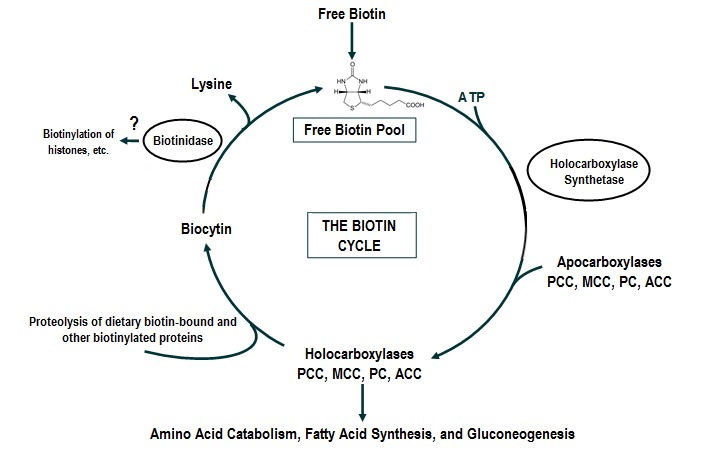Individuals with biotinidase deficiency who are diagnosed before they have developed symptoms (e.g., by newborn screening) and who are treated with biotin have normal development [Möslinger et al 2001, Weber et al 2004, Wolf 2017, Tankeu et al 2023] (see also Management, Targeted Therapy and Table 5). Neurologic problems, including seizures, optic atrophy, and hearing loss, occur only in those individuals with biotinidase deficiency who have recurrent symptoms and metabolic compromise prior to biotin treatment.
Untreated Profound Biotinidase Deficiency
Early onset. Symptoms of untreated profound biotinidase deficiency (<10% mean normal serum biotinidase activity) usually appear between ages one week and ten years, with a mean age of 3.5 months [Wolf et al 1985].
Some children with biotinidase deficiency manifest only a single finding, whereas others exhibit multiple neurologic and cutaneous findings.
Neurologic findings. The most common neurologic features in individuals with untreated profound biotinidase deficiency are seizures and hypotonia [Wolf 2011]. Older affected individuals often have ataxia and developmental delay.
Seizures are usually myoclonic but may be generalized and/or focal. Infantile spasms have also been observed.
Hypotonia. The degree of hypotonia varies but usually improves with biotin therapy. The degree of spasticity also varies but may not be reversible even after biotin intervention.
Spinal cord involvement. Some untreated older children and adolescents have exhibited progressive spastic paresis, limb weakness, and myelopathy [
Wolf 2015a].
Developmental delay / intellectual disability. Developmental delays may be global or specific, often with intellectual disabilities and speech-language issues, which if present prior to biotin treatment may or may not improve with biotin therapy.
Neuroimaging. Most brain imaging studies are normal. However, a variety of central nervous system abnormalities on brain MRI or CT have been reported [Wolf et al 1983b, Wastell et al 1988, Lott et al 1993, Salbert et al 1993, Grünewald et al 2004]. The most characteristic abnormalities include cerebral atrophy and ventricular dilatation. These findings may improve or resolve after biotin treatment.
Hearing impairment. Approximately 76% of untreated symptomatic individuals with profound biotinidase deficiency have sensorineural hearing loss that usually does not resolve or improve but remains static with biotin treatment [Wolf et al 2002]. Depending on the degree and/or pattern of hearing loss, children usually require hearing aids or even cochlear implants (see Management, Supportive Care).
Ophthalmologic involvement may include optic atrophy and scotoma [Salbert et al 1993].
Cutaneous manifestations include skin rash, alopecia, and recurrent viral or fungal infections caused by cellular immunologic dysfunction. These symptoms usually resolve with biotin therapy.
Respiratory problems including hyperventilation, laryngeal stridor, and central apnea can occur. These symptoms usually resolve with biotin therapy.
Gastrointestinal/feeding issues. Although feeding issues may occur prior to biotin treatment, they resolve with biotin therapy.
Late onset. A number of children with untreated profound biotinidase deficiency were asymptomatic until adolescence or adulthood, when they developed sudden loss of vision with progressive optic neuropathy, peripheral neuropathy, and spastic paraparesis [Ramaekers et al 1992, Lott et al 1993, Ramaekers et al 1993, Wolf 2015a, Deschamps et al 2018, Kellom et al 2021]. After several months of biotin therapy, the eye findings may improve or resolve and the spastic paraparesis may improve.
Untreated Partial Biotinidase Deficiency
Individuals with untreated partial biotinidase deficiency (10%-30% of mean normal serum biotinidase activity) may develop symptoms only when stressed, such as during infection.
One child with partial biotinidase deficiency who was not treated with biotin exhibited hypotonia, skin rash, and hair loss during an episode of gastroenteritis at approximately age six months. When treated with biotin, the symptoms resolved.
Prognosis
Because newborn screening (NBS) was rapidly incorporated into all state programs in the United States and in many countries, the window of opportunity to study symptomatic children has been limited compared to that of many other inherited metabolic disorders. Symptomatic children, if treated early enough, may experience reversal of all of their symptoms with biotin treatment.
The biochemical abnormalities and seizures rapidly resolve after biotin treatment, followed by improvement of the cutaneous abnormalities.
Hair growth returns over a period of weeks to months in children who have alopecia.
Optic atrophy and hearing loss may be resistant to therapy, especially if a long period has elapsed between their onset and the initiation of treatment.
Some treated children have rapidly achieved developmental milestones, whereas others have continued to show delays.
Many symptomatic children who experienced developmental delay, optic atrophy, and/or hearing loss prior to biotin treatment may find that the degree of the problem becomes static (i.e., does not progress), but also does not completely resolve. Children identified by NBS and treated shortly after birth, some in their fourth decade, have had successful outcomes [
Wolf 2017].
Early reported deaths in a few symptomatic individuals were due to severe metabolic compromise. Diagnosis of biotinidase deficiency and/or treatment with biotin was usually too late. Currently, such cases are fortunately rare due to NBS or to inclusion of the disorder in the differential diagnosis of symptomatic children. A normal life span is expected for both initially symptomatic children and those identified by NBS as long as they continue lifelong biotin supplementation. One death initially thought to be caused by sudden infant death syndrome was subsequently attributed to biotinidase deficiency [Burton et al 1987].
